This is the BEST Ropa Vieja — juicy braised beef infused with the flavors of tomatoes, bell peppers, onion, garlic and cumin. It’s a Cuban classic that can’t be missed and this post will show you how easy it is to make in an Instant Pot, the stovetop or slow cooker.
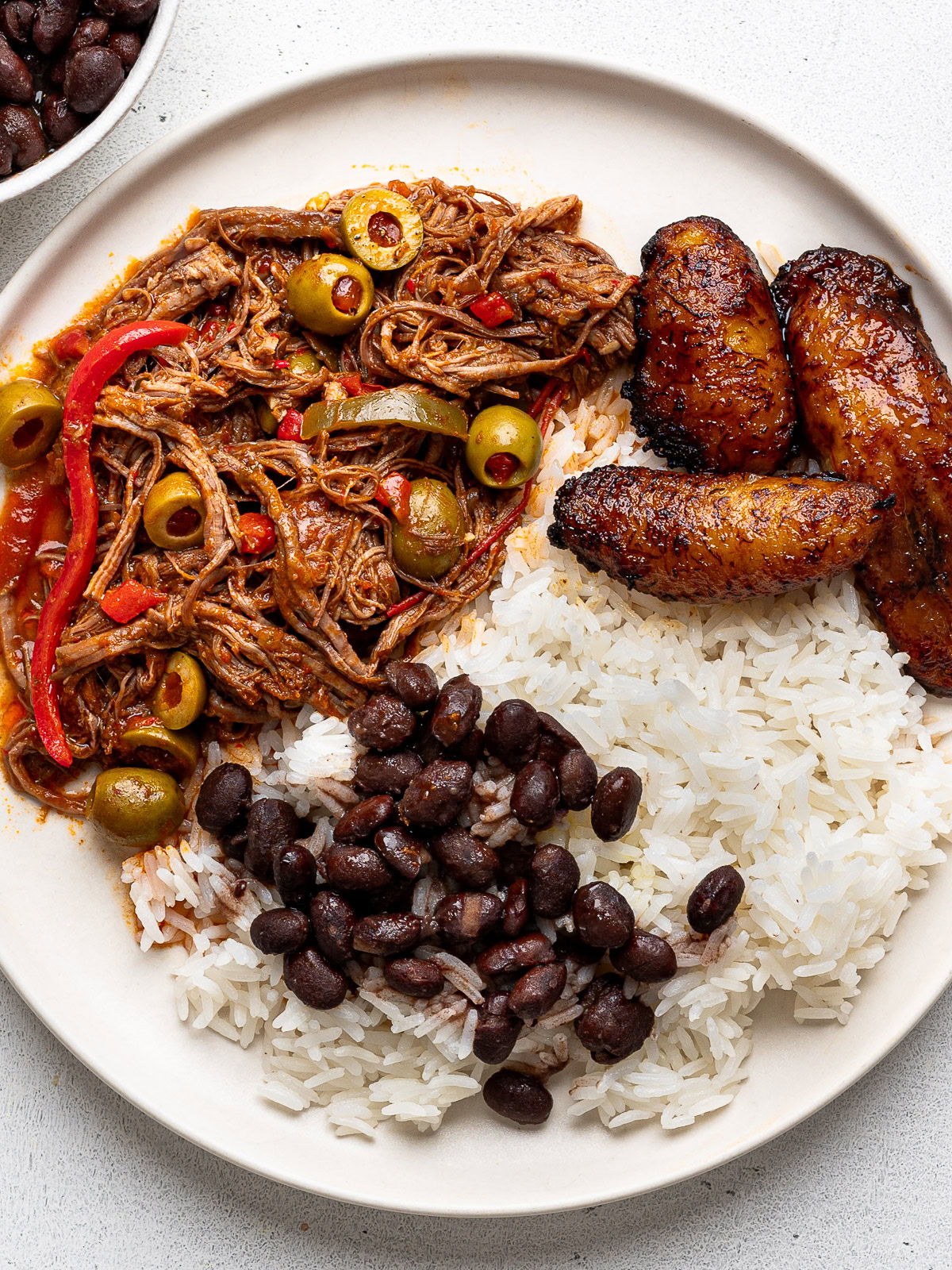
Let’s make one of my families all-time favorite Latin American dishes—Cuban Ropa Vieja. There are few Cuban dishes that capture the heart of Cuban culinary tradition quite like ropa vieja, a dish whose name translates to “old clothes” in Spanish.
This incredibly flavorful Cuban dish consists of shredded meat, peppers, tomatoes, onions and spices that are cooked until fall-apart tender. It is traditionally made with flank steak although other cuts of meat can be used.
- What Is Ropa Vieja?
- About This Ropa Vieja Recipe
- Why You Will Love This Ropa Vieja Recipe
- Ingredients And Notes
- Additions And Substitutions
- What Is The Best Cut Of Beef For Ropa Vieja?
- Do You Have To Brown The Meat First?
- How To Make Ropa Vieja (Instant Pot, Stovetop Or Slow Cooker)
- This Recipe Calls For Very Little Liquid. Will I Get The Burn Notice In The Instant Pot?
- Frequently Asked Questions
- Expert Tip
- What To Serve With Ropa Vieja
- Make Ahead, Storage And Reheating
- 5 sensational salad recipes, just for you
- More Delicious Recipes To Try
- Cuban Ropa Vieja
The beauty of Ropa Vieja is that even though it takes time to cook, it’s incredibly easy to make. This recipe is written so even a novice cook can easily throw it together. I hope you feel inspired to make this beloved Cuban dish—it’s comforting, gorgeous, and so delicious you’ll want to make it again and again.
What Is Ropa Vieja?
Ropa vieja, which translates to old clothes in Spanish, is considered by many to be the national dish of Cuba. It is a stew-like mixture of shredded beef with tomatoes, onions, garlic and bell peppers. The Ropa Vieja name of the dish likely came about because the shredded meat resembles the look of tattered, ripped rags.
It is traditionally made with flank steak, however other cuts of meat can also be used. My preference is flank because of how lean it is and because how nicely the meat shreds into long strands once it’s braised. I also prefer the texture of flank for Ropa Vieja. It may not be as soft and tender as brisket or chuck roast, but to me it tastes richer and more authentic.
Though Cubans have popularized this delicious dish, Ropa vieja, also known as carne desmechada or carne desmenuzada, is also popular in Panama, Venezuela, The Dominican Republic, Puerto Rico, Colombia, and many more Caribbean and latin American countries. Versions of Ropa vieja are also found throughout Spain and the Canary Islands.
Cuban Ropa Vieja is traditionally served with white rice, Cuban-style black beans and perhaps some maduros (fried sweet plantains). To me this makes the ultimate Cuban dish and after one bite, I’m sure you’ll understand why this rich and satisfying stew is the national dish of Cuba. It’s perfect for family meals, but will also delight any guest you serve it to.
About This Ropa Vieja Recipe
Never have I ever fallen more quickly in love with a dish than my first time tasting Ropa Vieja as a teenager (so yeah, eons ago). Also eons ago, I started making Ropa Vieja using Gloria Estefan’s recipe from her Estefan Kitchen cookbook (if you don’t know who she is, it’s because you’re way too young, but let’s just say if you ever found yourself dancing in a conga line, you can thank her).
That recipe served me well for many years and to this day, Ropa Vieja is the most requested dish by my adult children. This beloved Cuban dish is incredibly easy to make. It just requires some time for the meat to braise until fall-apart tender, but it’s mostly hands-off.
However, if you have an Instant Pot, it’s truly a game changer for making ropa vieja. Any dish that needs long, slow cooking in a moist environment will become succulent a lot faster in an electric pressure cooker—and this stew-like dish is no exception. It cooks the flank steak (or whatever cut of meat you’re using) in a fraction of the time, making it much more tender, and easier to shred.
If you don’t own an Instant pot, you can of course make it on the stovetop, or in a slow cooker. I include instructions for all of the methods in the printable recipe card below.
Why You Will Love This Ropa Vieja Recipe
- Delicious and unique flavors: Flavorful ingredients and spices come together to make this Cuban dish truly unforgettable.
- Simple ingredients: Aside from the meat, this recipe is made with mostly pantry ingredients.
- Meal Prep: My favorite part about this Cuban dish is that it tastes just as fabulous the next day, or even days after you make it. This makes it the perfect dish for make-ahead meals, or for entertaining.
- Versatile Cooking Methods: Though I find the Instant Pot the easiest way to cook Ropa Vieja, it turns out just as fabulous on the Stove Top, in a Slow Cooker, or a Stove Top/Oven Combo. All cooking methods are provided in this post.
Ingredients And Notes
This is an overview of the main ingredients you will need to make this recipe. Be sure to check the printable recipe card below for the complete list of ingredients and their exact quantities.

- Beef: Ropa Vieja is traditionally made with flank steak and that is what I have always used. You will need about 2 pounds of flank steak for this recipe. In the section down below I discuss other options for cuts of beef that can be used. You can also make this recipe using pork shoulder. Just cook it for 3-4 hours in the oven until fall-apart tender, or in the Instant Pot for 1 hour (or more depending on the size).
- Bell Peppers: Bell peppers are a main ingredient in Ropa Vieja. Both green and red peppers are pretty standard and in my opinion lend the best authentic flavor to this dish.
- Jarred pimento or roasted red peppers: Jarred pimentos are often added to a Cuban Ropa Vieja but they are extremely hard to find anywhere near me so I use jarred roasted red peppers. It was only a few years ago that I learned there is a difference between the two. However, jarred red roasted peppers add a nice smokiness that I quite like in my Ropa Vieja. If you can’t find either, just leave them out. TIP: Do not buy hot pimentos – Ropa Vieja is not supposed to be spicy.
- Onion and garlic: Here we use a lot of garlic and onion for maximum flavor.
- Tomato sauce: When Cuban, Dominican, and Puerto Rican recipes call for tomato sauce, they typically mean a pureed, smooth tomato sauce. You can use any pureed tomato you like, such as passata, Pomi, Hunts, Mutti polpa, etc. Or puree your own from canned whole tomatoes. You can also use chopped fresh tomatoes but if doing so, add a few tablespoons of concentrated tomato paste to give it a richer tomato flavor. However, keep in mind Ropa Vieja should not have a heavy tomato presence. It should be saucy, not overly thick.
- White Wine: I find the wine pretty essential in this dish. It adds a lot of great flavor and is also a crucial liquid for the sauce.
- Spices and seasonings: Here we are using dried oregano, ground cumin, sweet paprika, bay leaves, salt and ground black pepper. The paprika is not very traditional in a Cuban Ropa Vieja but I find it adds great color and a little more depth of flavor to the dish.
- Pimento Stuffed Olives: Well, here’s the ingredient that could get me in a bit of trouble with some of my Cuban friends. Olives are not traditional in a Cuban Ropa Vieja. It seems olives are more commonly added to the Puerto Rican and Dominican versions of this dish. I adore briny olives, and I’m Dominican, so I do add them here but the dish is just as delicious without them so feel free to omit them if your abuela, or tatara-abuela never did.
- Vinegar: Particularly if skipping the olives, you want to add a little acidity to the sauce. I use red wine vinegar but apple cider vinegar, white vinegar, or white wine vinegar, will also work.
Additions And Substitutions
Beef – You can also make this recipe using pork shoulder. Just cook it for 3-4 hours in the oven until fall-apart tender, or in the Instant Pot for 1 hour (or more depending on the size).
Green pepper – I adore green peppers and I feel their bitter, grassy flavor really contributes to this Ropa Vieja recipe. However, I know some people do not like green peppers at all, in this case try using a cubanelle pepper (much milder) or use any other coloured bell pepper in its place.
White wine – You can also use red wine if that is all you have on hand. If you are avoiding alcohol, you can substitute with beef broth or chicken broth. In a pinch, you could also use water.
Spices – You can also add a teaspoon of smoked paprika if you like smoky flavors.
Make it vegan – Surprisingly, this is a great recipe to make vegan. When my son was vegan a few years ago, I made ropa vieja using jackfruit and it was delicious. Simply make the sauce in a skillet, then add your drained and shredded jackfruit. Cook for 15 minutes, or so, then add the vinegar, and olives (if using).
What Is The Best Cut Of Beef For Ropa Vieja?
Traditional Cuban Ropa Vieja has always been made with flank steak. It always surprises people that flank steak can be simmered in water to tenderize it, but it does work. Once tender, the pieces of flank steak easily shred into long strands to give Ropa Vieja its unique characteristic of looking like torn, old rags of clothing.
Through the years, many recipes have started calling for chuck roast, skirt steak, or brisket because even after hours of simmering flank steak, it can still be a little tough. However, I have tried these other cuts and though they do make a pretty delicious Ropa Vieja, I miss the ever so slightly chewier strands from a flank steak.
Unfortunately, like most cuts of beef, flank steak has gotten ridiculously pricey. If you find chuck or brisket at a much more reasonable price, go ahead and use that. You just may have to cook it a little longer so it’s fall-apart tender. Skirt steak, on the other hand, is thinner than flank so it would need less time to cook.
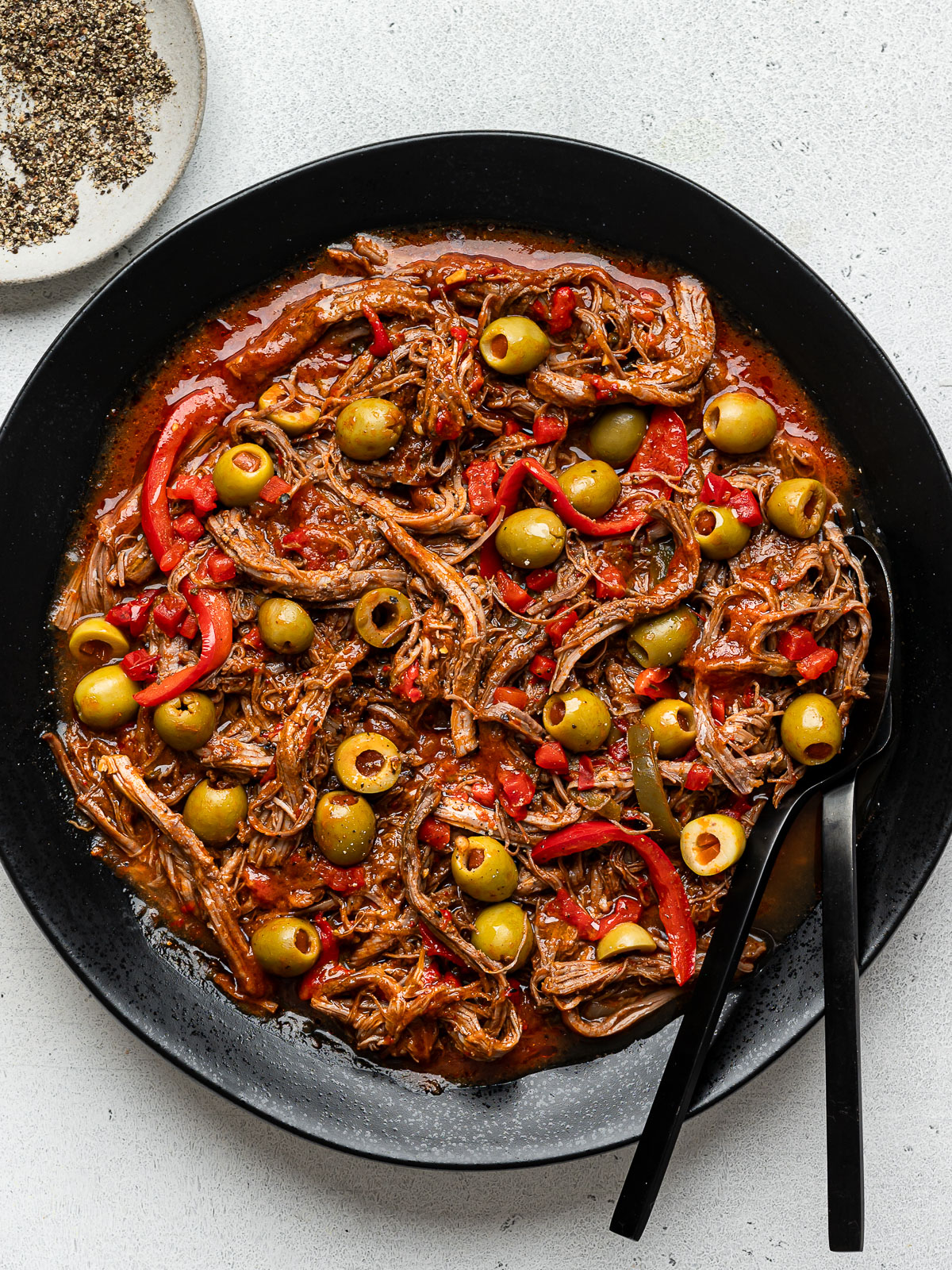
Do You Have To Brown The Meat First?
Some recipes call for browning the meat before cooking the sauce because they believe it will add more flavor. In this recipe, we are skipping this step. Particularly if using flank steak, I find this step unnecessary and if anything, I find it drys out the meat.
Pretty much all of the “authentic” Cuban recipes I have researched, do not brown the meat first, no matter what cooking method they are using. I have tested it both ways and could not tell a difference so it’s definitely not worth the extra time and effort.
How To Make Ropa Vieja (Instant Pot, Stovetop Or Slow Cooker)
Here we are focusing on Ropa Vieja made in an Instant Pot. Once I used the Instant pot to make this dish, it was hard to go back to another method. However, I know many of you don’t have an Instant Pot so you can find instructions for how to make it on the stovetop, or in a slow cooker, in the recipe card below.
Note: This is an overview on how to make Ropa Vieja. For detailed instructions check the recipe card below.
Step 1: Slice the flank steak, crosswise, into 2 or 3 large pieces. If using chuck or brisket, you may need to cut them into a few more pieces. Set aside.
Step 2: Turn the Instant Pot to SAUTE. Add 1 tablespoon of the oil. Once the oil is hot and shimmering, add the onion and bell peppers to the pot. Sauté until slightly tender, about 3-4 minutes. At this point, I like to scoop out about 1/3 of the sautéed peppers to add later but this is optional.
Step 3: Next, add the garlic, oregano, cumin, and paprika and sauté for 1 minute more. Add the wine and cook until the liquid is slightly reduced, about 1 minute.

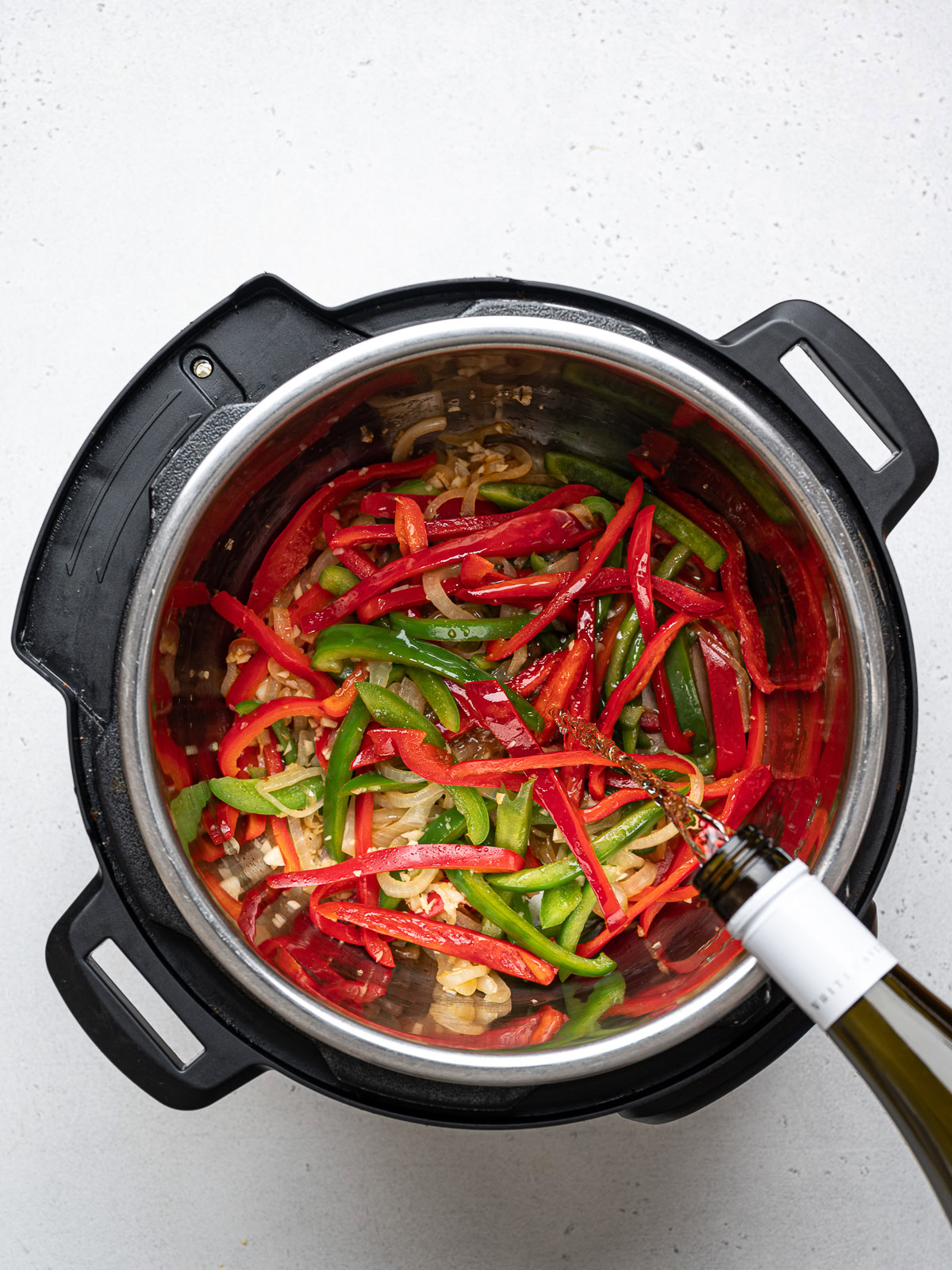
Step 4: Add the tomato sauce, bay leaves and season with salt and pepper. Nestle in the pieces of meat, making sure they are mostly covered in liquid. I also like to place a few of the sautéed vegetables on top of the meat.
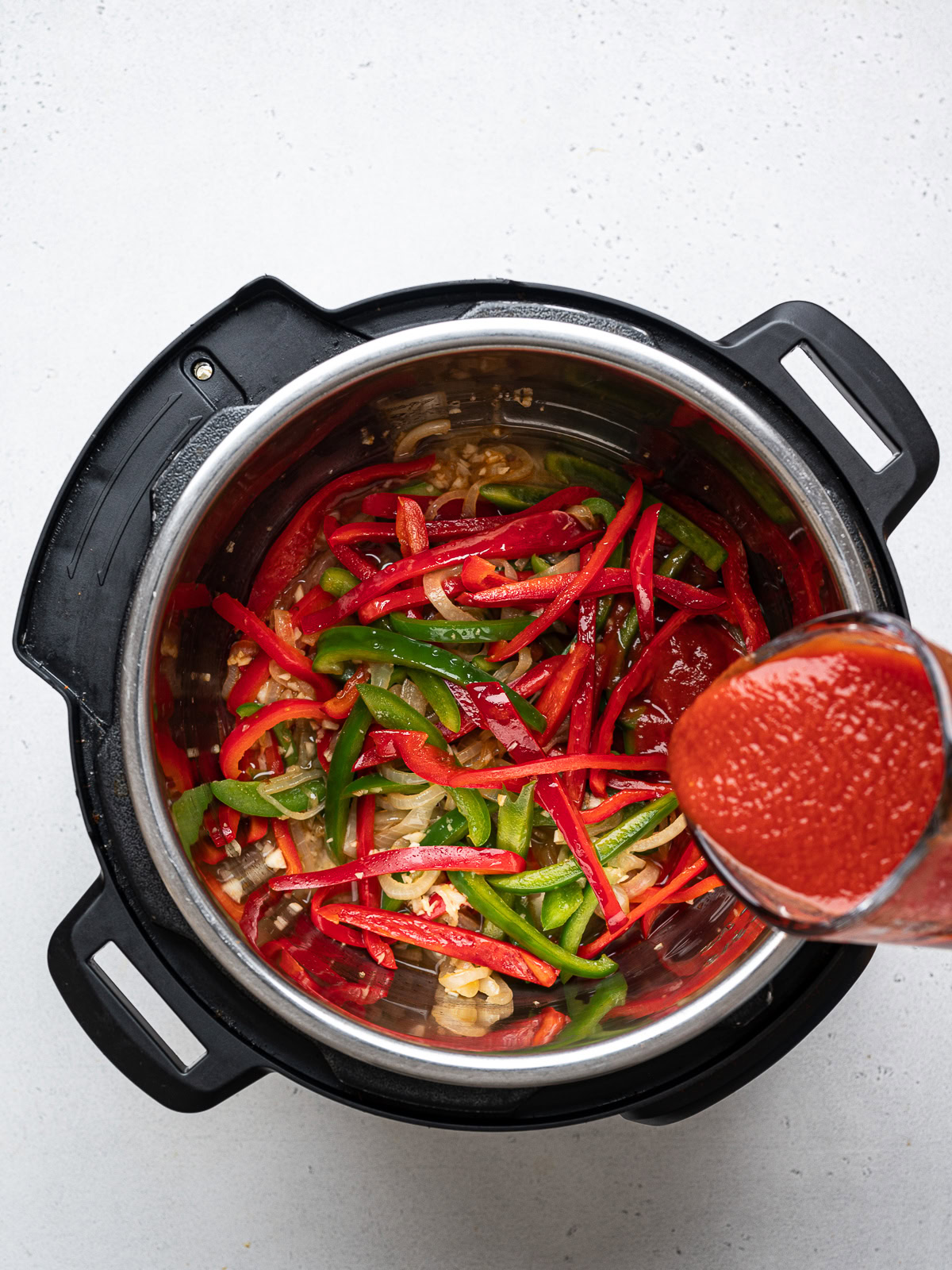

Step 5: Turn the valve to “sealing” and set the Instant Pot to pressure cook at HIGH pressure for 45 minutes. Allow the pressure to have a natural release of 15 minutes, then do a quick release manually.
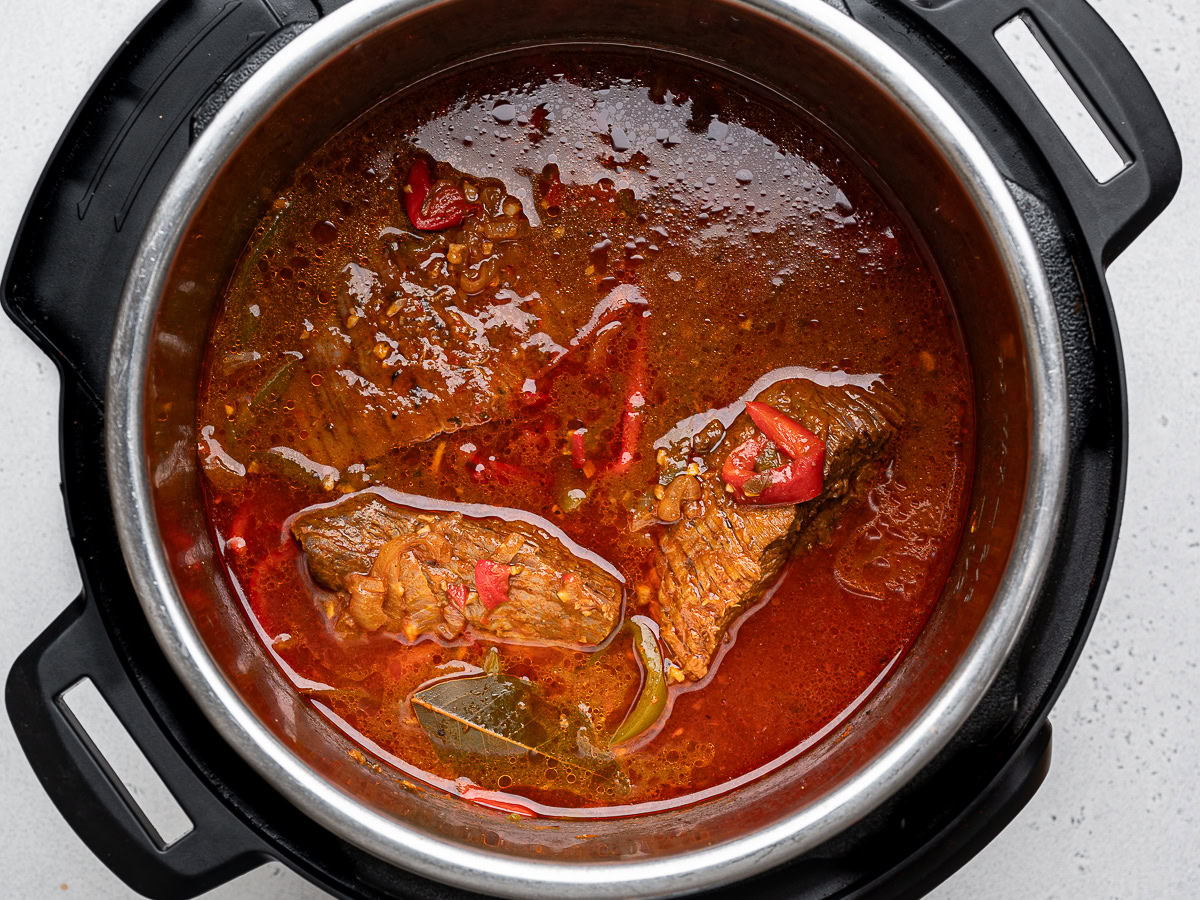
Step 5: When the steam stops, carefully remove the lid and remove and discard the bay leaves. Transfer the beef to a bowl. Using 2 forks, shred the beef into bite-size pieces. Return the beef to the pot and add the reserved peppers, vinegar, pimentos and olives, if using. Once again, set the pot to SAUTE and simmer until the liquid is slightly reduced, about 10 minutes. Taste and adjust seasoning by adding a little more salt and pepper, if needed.



Step 6: Serve with rice, black beans, plantains, or tucked into tortillas.

This Recipe Calls For Very Little Liquid. Will I Get The Burn Notice In The Instant Pot?
The only liquid we are using in this recipe is white wine and tomato sauce. I know that makes a lot of people nervous that they will get the dreaded burn notice. Let me assure you, you will not. I have made this Ropa Vieja recipe in the Instant Pot dozens of times and never once have I gotten the burn notice.
The vegetables and meat will release a lot liquid so if you add broth, or water, you will end up with a sauce that is too loose and flavorless. Just make sure to stir the bottom of the pot once you add the wine and tomato sauce, and you will avoid any chance of getting the burn notice.
If for some inexplicable reason the burn message were to appear, there is no need to panic. Just release the pressure, open the lid, and give everything a good stir. Then lock the lid and continue with the recipe.
Frequently Asked Questions
This Instant Pot Ropa Vieja recipe is not spicy at all. It is made with sweet bell peppers, never spicy peppers. If you love heat and would like th add some spice, add a few pinches of cayenne pepper.
No they are not. Pimentos are small, heart-shaped peppers that measure about 3-4 inches in height. They are sweeter than roasted red bell peppers and a little more aromatic. Pimentos are almost always sold jarred in brine liquid, as opposed to fresh. Sometimes, the two can be used interchangeably and for this recipe, you can use either one.
You can! I would use 3 pounds of boneless skinless chicken thighs, then follow the recipe as written reducing the cooking time as follows:
Instant pot: Cook the chicken for 12 minutes.
Stovetop: Cook the chicken for 25-30 minutes or until fall-apart tender.
Slow cooker: Cook on low for 6-8 hours, or on high for 3-4 hours.
Yes! Surprisingly, this is a great recipe to make vegan. Jackfruit is a great replacement for the beef because it shreds and absorbs flavors beautifully. Simply make the sauce in a skillet, then add your drained and shredded jackfruit. Cook for 15 minutes, or so, then add the vinegar, and olives (if using).

Expert Tip
Do not be tempted to add more liquid. This Instant Pot recipe calls for very liquid which I know makes a lot of people nervous. The recipe has been tested dozens (and dozens!) of times and it works beautifully as written. If you add broth or water, I guarantee your ropa vieja will not taste as rich or flavorful.
What To Serve With Ropa Vieja
For my family, Ropa Vieja is a full on Latin American culinary affair so white rice, black beans, and sweet plantains are a must. That said, Ropa Vieja is also fabulous served with many other sides, or used in many different ways. Here’s a few suggestions:
- Sliced Avocados – If we aren’t having plantains with our ropa vieja, we are most definitely having sliced avocados on the side. Don’t forget to drizzle the avocados with lime juice and a sprinkle of salt.
- With a cabbage slaw – A side of briny, crunchy slaw is wonderful alongside rtropa vieja. Try it with this easy Curtido recipe – yum!
- With roasted potatoes, mashed potatoes, sweet potatoes or French fries – This Cuban Ropa Vieja would be delicious with potatoes of any kind.
- With polenta – A creamy polenta would be a great base for the saucy Ropa Vieja.
- As a filling for tacos, quesadillas, taquitos, tostadas, burritos, or enchiladas – Drain out some of the excess sauce and this Ropa Vieja makes the perfect filling for all of your favorite Mexican dishes.
Make Ahead, Storage And Reheating
- Make Ahead: Cuban Ropa Vieja is even better after it sits for days in the fridge. So go ahead and prepare the entire dish, then store in the refrigerator until ready to use for up to 4 days.
- To store in the fridge: Leftovers can be stored in an airtight container in the refrigerator for 4-5 days.
- To freeze: Ropa vieja also freezes beautifully. Once cooled, place in a freezer-safe container and freeze for up to 3 months. When ready to use, thaw overnight in the refrigerator.
- Reheating: For best results, reheat the Ropa Vieja in a sauce pan, over medium-low heat, until heated through.

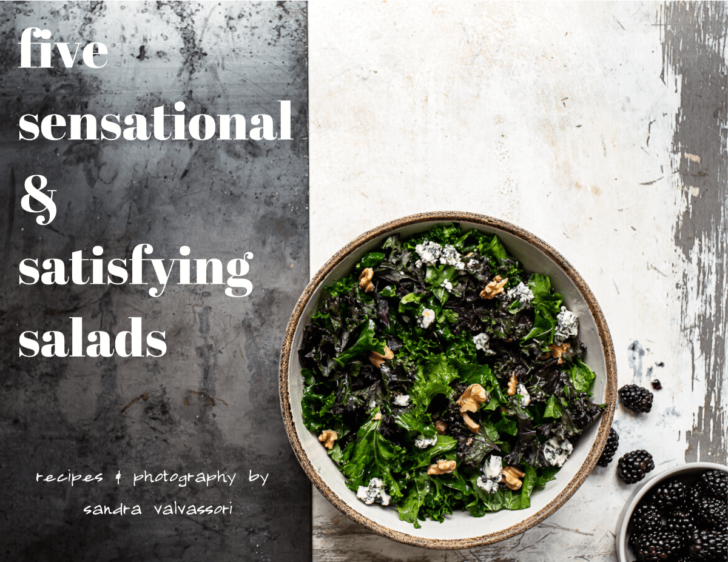
5 sensational salad recipes, just for you
Join to receive the free e-cookbook.
More Delicious Recipes To Try
I hope you love this Ropa Vieja (Instant Pot, Stovetop, or Slow Cooker) recipe. If you make it, please leave a comment and star rating at the bottom of the page so I know how you liked it. Thank you!
Cuban Ropa Vieja
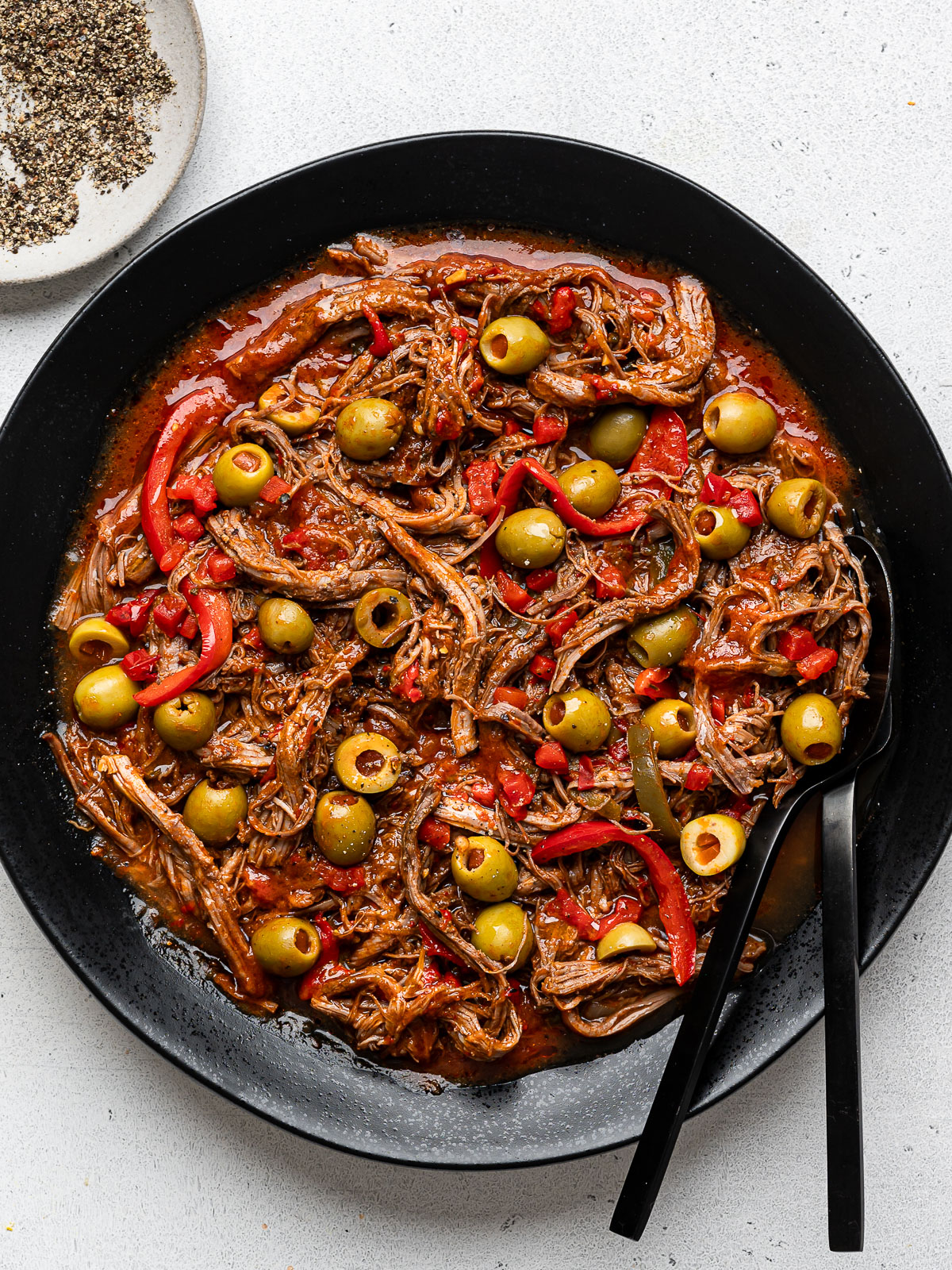
Ingredients
- 2 pounds flank steak (see notes)
- Kosher salt and freshly ground black pepper
- 2 Tablespoons olive oil
- 1 large yellow onion halved and thinly sliced
- 1 large green pepper, seeded and thinly sliced
- 2 red bell peppers, seeded and thinly sliced
- 4 garlic cloves minced
- 1 1/2 teaspoon dried oregano
- 2 teaspoons ground cumin
- 2 teaspoons paprika
- 2 bay leaves
- 1/2 cup (125 ml) dry white wine
- 1 cup beef or chicken broth (NOT FOR INSTANT POT, SEE NOTES)
- 1 14-ounce can pureed tomato sauce (see notes)
- 1 Tablespoon red wine vinegar (or other light colored vinegar)
- 1/3 cup chopped jarred pimentos (optional)
- 1/2 cup pitted green olives (optional)
- cooked white rice and black beans or pinto beans, for serving
Instructions
FOR THE INSTANT POT
- Slice the flank steak, crosswise, into 2 or 3 large pieces so it can fit in the Instant Pot in almost even layer. Season beef with a few pinches of salt and pepper. Set aside.
- Turn the Instant Pot to SAUTE and add the oil. Once the oil is hot and shimmering, add the onion and bell peppers to the pot. Sauté until slightly tender, about 3-4 minutes. At this point, I like to scoop out about 1/3 of the sautéed peppers to add later, but this is optional.
- Add the garlic, oregano, cumin, paprika and bay leaves and sauté for 1 minute more. Add the wine and use a flat wooden spoon or spatula to scrape up any browned bits on the bottom of the pot. This will ensure that you do not get a burn warning during the pressure cooking process.cook until the liquid is slightly reduced, about 1 minute. Add the tomato sauce, stir, and season with salt and pepper.
- Nestle in the pieces of meat, making sure they are mostly covered in liquid. I also like to place a few of the sautéed vegetables on top of the meat.
- Turn the valve to “sealing” and set the Instant Pot to pressure cook at HIGH pressure for 45 minutes. Let the pressure release naturally for 15 minutes, then release the remaining pressure manually.
- When the pressure is done releasing, carefully remove the lid and discard the bay leaves. Transfer the beef to a bowl. Using 2 forks, pull apart into very thin, long shreds. Return the beef to the pot and add the reserved peppers, vinegar, pimentos and olives, if using.
- Once again, set the pot to SAUTE and simmer until the liquid is slightly reduced, about 10 minutes. Taste and adjust seasoning by adding a little more salt and pepper, if needed.
- Serve with rice, black beans, plantains, and/ or sliced avocados.
FOR THE SLOW COOKER
- Slice the flank steak, crosswise, into 2 or 3 large pieces so it can fit in the slow cooker in almost even layer. If using a chuck roast, you may need to cut it into a few more pieces. Season beef with a few pinches of salt and pepper. Set aside.
- In a slow cooker, combine the olive oil, onions, peppers, garlic, oregano, cumin, paprika, and bay leaves. Give everything a good toss to coat in oil. Pour in the wine, tomato sauce, PLUS 1/2 cup beef broth, chicken broth or red wine. Mix gently to combine.
- Nestle in the pieces of meat, making sure they are mostly covered in liquid. I also like to place a few of the vegetables on top of the meat. Cook covered, on low for 8 hours, or on high for 5 hours or until the beef seems very tender.
- Transfer the beef to a bowl (keep slow cooker covered). Using 2 forks, shred the beef. Return the beef to the pot and add the vinegar, pimentos and olives, if using. Cook on high, covered, for 20 minutes or until beef has warmed through. Taste and adjust seasoning by adding a little more salt and pepper, if needed.
- Serve with rice, black beans, plantains, and/ or sliced avocados.
FOR THE STOVETOP
- Slice the flank steak, crosswise, into 2 or 3 large pieces so it can fit a Dutch oven or large pot in almost even layer. Season beef with a few pinches of salt and pepper. Set aside.
- Heat oil in a large Dutch oven over medium heat. Add the onion and bell peppers and sauté until slightly tender, about 3-4 minutes. At this point, I like to scoop out about 1/3 of the sautéed peppers to add later, but this is optional.
- Add the garlic, oregano, cumin, paprika and bay leaves and sauté for 1 minute more. Add the wine and cook until the liquid is slightly reduced, about 1 minute. Add the tomato sauce PLUS 1 cup beef or chicken broth (*see notes). Season with salt and pepper.
- Nestle in the pieces of meat, making sure they are covered in liquid and vegetables (add more broth if necessary).
- Cover Dutch oven, leaving lid slightly ajar. Bring to a simmer and cook beef until very tender, about 2 hours. Alternatively, you can cook it in the oven; transfer the pot to a 325ºF preheated oven, with lid slightly ajar, and cook for 1 1/2 – 2 hours, adding more broth if necessary.
- Discard the bay leaves. Transfer the beef to a bowl. Using 2 forks, pull apart into very thin, long shreds. Return the beef to the pot, stirring to combine with vegetables and sauce. Add the reserved peppers, vinegar, pimentos and olives, if using.
- Bring to a simmer, and cook, uncovered, until sauce has thickened slightly, about 15 minutes. Taste and adjust seasoning by adding a little more salt and pepper, if needed.
- Serve with rice, black beans, plantains, and/ or sliced avocados.



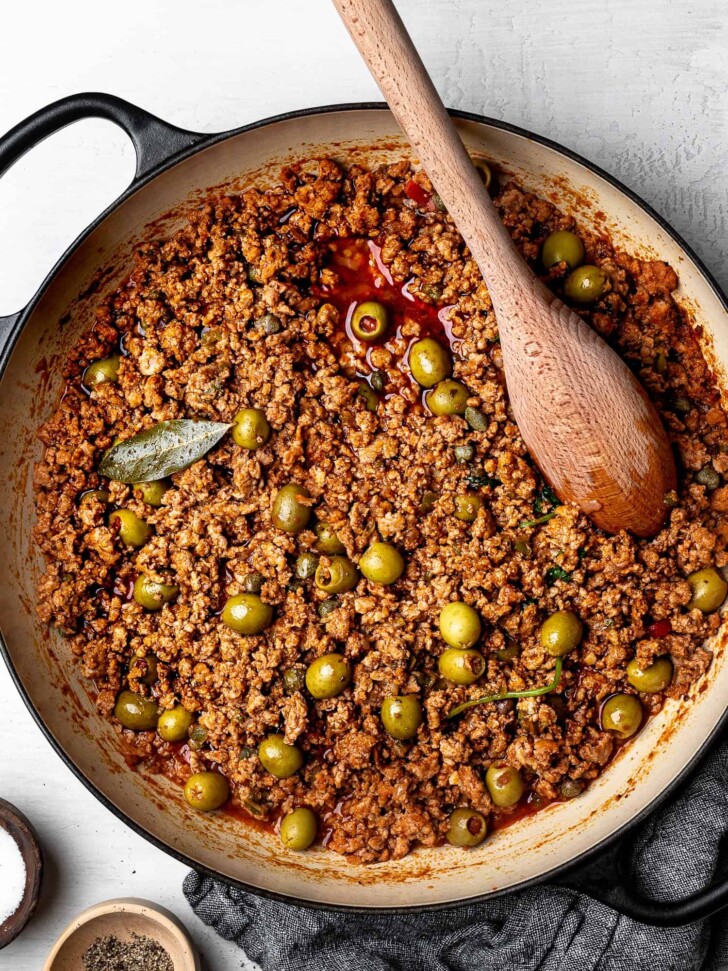
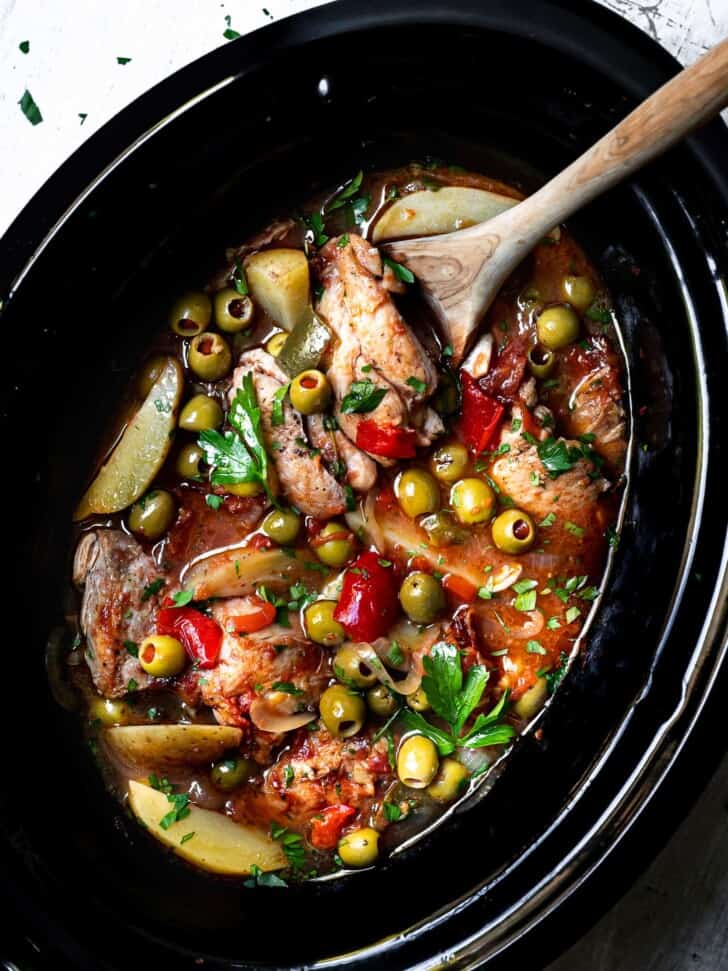
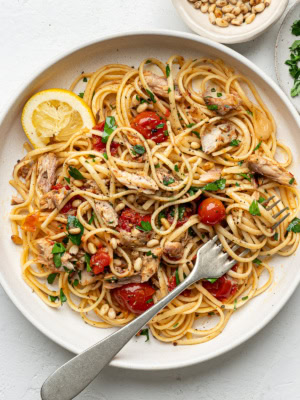
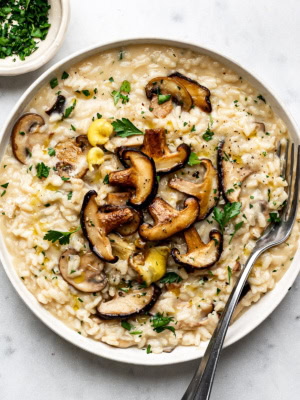

Join the Conversation